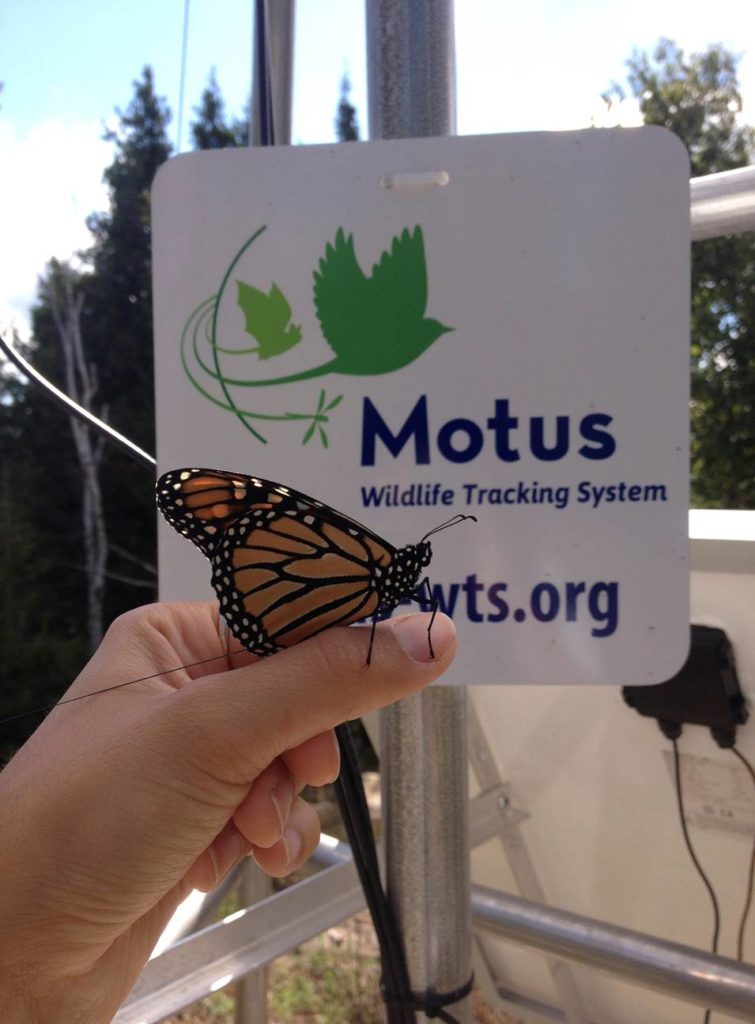
[Pittsburgh, Pennsylvania, April 27, 2020] — A major grant from the U.S. Fish and Wildlife Service (USFWS) will enable Carnegie Museum of Natural History’s Powdermill Avian Research Center (PARC) in collaboration with several state wildlife agencies and wildlife-centered nonprofit organizations to dramatically expand a new migration tracking system across the northeastern United States.
The award, totaling $1.35 million, with $600,000 designated for PARC project costs, provides critical backing for expanding and refining the use of highly miniaturized transmitters — some weighing just 1/200th of an ounce — and an array of strategically-placed receiver towers to track the movements of birds, bats, and even creatures as small as dragonflies and monarch butterflies from distances as great as nine miles.
The grant will allow the partners to establish 50 automated telemetry receiver stations in New York, Massachusetts, Connecticut, Vermont, Rhode Island, New Hampshire, and Maine. All new receiver towers will be part of the rapidly expanding Motus Wildlife Tracking System, established in 2013 by Bird Studies Canada, which already includes nearly 900 such stations around the world. In addition to state wildlife agencies for Pennsylvania, New Hampshire, Massachusetts, and Maine, partners for the project include the Willistown Conservation Trust in Chester County; the Ned Smith Center for Nature and Art in Dauphin County; Project Owlnet, a nationwide cooperative research initiative, and New Hampshire Audubon, Massachusetts Audubon and Maine Audubon.
Besides significantly increasing the telemetry infrastructure across the Northeast, this new USFWS grant specifically targets several species of greatest conservation need in New England. Research collaborators will use nanotag transmitters to study the migration routes, timing, and behavior of American Kestrels, the region’s smallest falcon and a bird that has experienced drastic and largely unexplained declines across New England. Other scientists will use the smallest nanotags to track the movements of monarch butterflies from the region, a species whose dramatic population declines have prompted their consideration for federal listing as endangered, but also a species whose migration has been under-studied.
This is the second major USFWS grant for Motus expansion in our region. In 2018, the agency awarded the collaboration about $500,000 to build 46 receiver stations in Maryland, Delaware, New Jersey, Pennsylvania, and New York. The collaboration had already constructed a 20-receiver array across Pennsylvania in 2017 using private, foundation, and state grant funds.
Additional information about Motus technology, including images of receiving towers and tiny transmitters can be found at https://powdermillarc.org/motus-wildlife-tracking/.
A COVID-19 CONNECTION
In addition to grant proposal work, Luke DeGroote, Avian Research Coordinator at Powdermill Nature Reserve, has been busy this spring addressing the impact of Covid-19 on a more traditional form of wildlife tracking, bird banding.
This year marks the 100th anniversary of the United States Bird Banding Laboratory. Through the careful capture, marking, and release of wild birds, researchers have been able to understand much about various species’ migration patterns, population shifts, life histories, and productivity.
DeGroote is Chair of the North American Banding Council, a nonprofit group of avian researchers who use bird banding as a tool in ornithological research, conservation, and management. In that leadership position he helped draft guidance for banding birds during the COVID-19 pandemic, a document containing recommendations now being followed not only by the Powdermill Avian Research Center, but by other long-term bird banding stations such as Long Point Bird Observatory in southern Ontario, and the Manomet Banding Lab in Plymouth, Massachusetts.
Because many bird banding operations are team efforts, involving delicate work performed rapidly in close quarters, these projects cannot be carried out while participants maintain safe physical distancing. As the guidelines state, “Any bird, mist net, bird bag, or other equipment touched by more than one person has the potential to transmit the virus.”
Careful informed decisions on a case-by-case basis are the guideline’s ultimate recommendation, advice echoed by DeGroote in summarizing the widespread uncertainty fostered by Covid-19.
“It is tragic that for the first time in 60 years spring bird migration won’t be documented by the bird banding operation at Powdermill, but in the long-term, future scientific insights provided by the decades of work here won’t be harmed by a single missed season,” says DeGroote. “The guidelines exist because collectively, we as society and bird banders, are grappling with what it means to be “essential.” We believe that the work we do is critical to conservation and therefore our health as a society. At the same time, it is directly at odds with the current efforts to slow the spread of Covid-19.”
